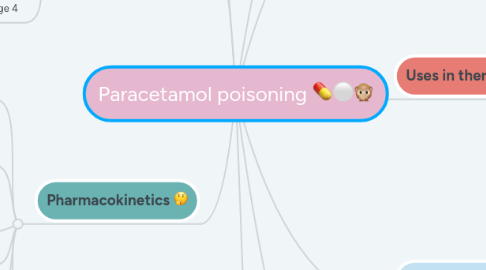
1. Pharmacokinetics 🤔
1.1. Rabidly absorbed from small intestine
1.2. Peak plasma conc occur within :
1.2.1. 1-2 hrs ➡️ tab⚪ and capsule 💊
1.2.2. 30 mins ➡️ liq.preparations
1.2.3. 4 hrs ➡️ SR preparation
1.3. Peak plasma conc after therapeutic doses ➡️20 mg/L
1.4. About 20% plasma protein bound and may increase to 50% in case of overdose
1.5. Excretion: urine
1.6. Half life ➡️2 hrs but in liver dysfunction up to➡️ 17 hrs
2. Phases of toxicity
2.1. Stage 1
2.1.1. Begins within (0.5-24) hrs and there is no specific symptoms (vomiting ,nausea ,anorexia , malaise ,diaphoresis)
2.2. Stage 2
2.2.1. Begins within (1-3 )days State of being well ( improve symptoms)- ⬆️ALT and ⬆️AST -PT may be prolonged -Right upper quadrant tenderness.
2.3. Stage 3
2.3.1. -within (3-5) days -Acute liver failure -Renal failure
2.4. Stage 4
2.4.1. -Within (5days -3 weeks). -Recovery stage . -the enzymes return to normal but hepatic necrosis persist.
3. Management of toxicity
3.1. 1-Gut decontamination :is most helpful if performed within (2hrs )of ingestion.
3.1.1. 1-Emesis: -Inducing vomiting with syrup of ipecac -has no role as ipecac induced vomiting delays the effective administration of activated charcoal and oral acetylcysteine.
3.1.2. 2-Gastric lavage: -It can be performed within 60 minutes of ingestion. - Done when amount ingested is potentially life-threatening.
3.1.3. 3-Activated charcoal: - It is the most common as reduces the absorption. -the most benefit within ( 30 min - 2 hrs ) -done later than 2 hours in patients with delayed gastric emptying.
3.2. 2-Hemodialysis and Hemoperfusion
3.2.1. -for rare situations: -early coma and metabolic acidosis are present prior to the onset of hepatic dysfunction and in the setting of a substantially elevated APAP concentration (over 1000 mg/L).
3.3. 3-Liver transplantation
3.3.1. In severe hepatotoxicity and potential to progress to hepatic failure. Putting in consideration: -Metabolic acidosis, unresponsive to resuscitation ,Renal failure, Coagulopathy and Encephalopathy.
3.4. Prevention
3.4.1. Paradote: (co-methiamol ) a combination tablet containing 100 mg methionine and 500 mg Paracetamol.
3.4.2. Methionine is considered as an alternative( antidote) for paracetamol.
4. Toxic dose
4.1. -In adult: 7.5-10 g - Children: 150 mg/kg
5. Uses in therapeutic dose :😃
5.1. Non-narcotic analgesic
5.2. Anti-pyretic
5.3. Weak anti-inflammatory activity
5.4. Substitute for Aspirin in case of :
5.4.1. Peptic ulcer
5.4.2. Coagulation disorder
5.4.3. Viral infection to avoid risk of Reye's syndrome
